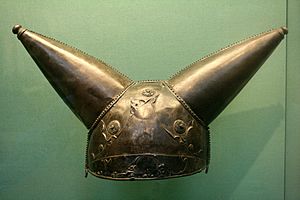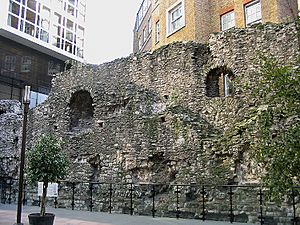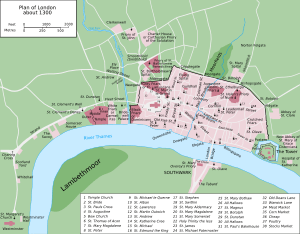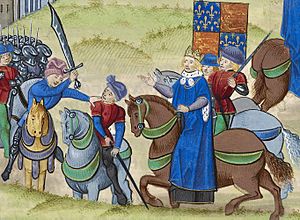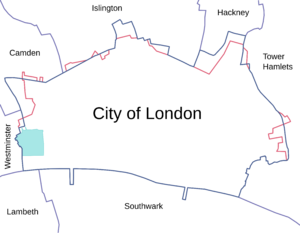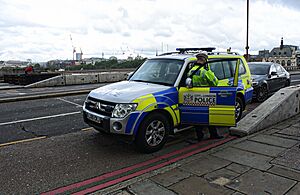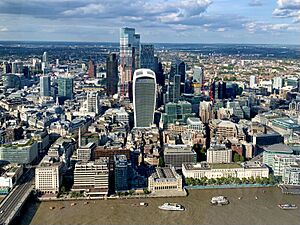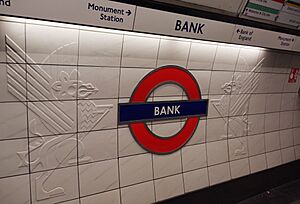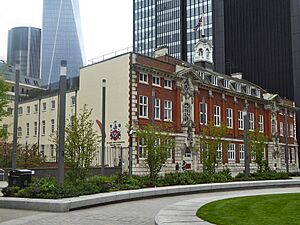City of London facts for kids
Quick facts for kids
City of London
|
|||
|---|---|---|---|
|
|
|||
|
|||
| Nicknames:
the Square Mile, the City
|
|||
| Motto(s): | |||
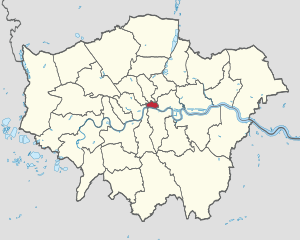
Location within Greater London
|
|||
| Status | Sui generis; city and ceremonial county | ||
| Sovereign state | United Kingdom | ||
| Country | England | ||
| Region | London | ||
| Roman settlement | c. 47 AD (Londinium) | ||
| Wessex resettlement | 886 AD (Lundenburg) | ||
| Wards |
25 wards
Aldersgate
Aldgate Bassishaw Billingsgate Bishopsgate Bread Street Bridge Broad Street Candlewick Castle Baynard Cheap Coleman Street Cordwainer Cornhill Cripplegate Dowgate Farringdon Within Farringdon Without Langbourn Lime Street Portsoken Queenhithe Tower Vintry Walbrook |
||
| Government | |||
| • Body | City of London Corporation | ||
| Area | |||
| • City | 1.12 sq mi (2.90 km2) | ||
| Highest elevation | 69 ft (21 m) | ||
| Lowest elevation | 0 ft (0 m) | ||
| Population
(2020)
|
|||
| • City | 9,721 | ||
| • Rank | 313th (of 326) | ||
| • Density | 8,682/sq mi (3,352/km2) | ||
| Time zone | UTC±00:00 (GMT) | ||
| • Summer (DST) | UTC+01:00 (BST) | ||
| Postcodes |
EC, WC, E
|
||
| Area code(s) | 020 | ||
| Geocode | |||
| Police | GB-LND | ||
| Patron saint | St. Paul | ||
The City of London, often called the City, is a special area in London, England. It's like a small city within a much bigger city! It's the ancient heart of London and a major global center for finance and business.
For many centuries, the City of London was all of London. But over time, the city grew much larger. Now, the City of London is just a small but very important part of the huge Greater London area. It's sometimes called the Square Mile because it's only about 1.12 square miles (2.9 square kilometers) in size.
The City has its own unique government, called the City of London Corporation. This government is different from other local councils in the UK. It even has its own police force! The head of the City of London Corporation is the Lord Mayor of London, which is a very old and important role. The current Lord Mayor is Michael Mainelli.
Many famous places are in the City, like St Paul's Cathedral, the Bank of England, and the London Stock Exchange. It's a busy place where over 500,000 people work every day, mostly in finance and business.
History of the City of London
Early Beginnings
The story of the City of London began around AD 43, when the Romans built a settlement called "Londinium." This place became a busy port and trading hub because it had a bridge over the River Thames. The Romans even built a big wall around the city between AD 190 and 225. This wall helped define the City's boundaries, which are still quite similar today. At its busiest, Londinium had about 45,000 to 60,000 people from all over the Roman Empire.
However, the Roman Empire faced problems, and by AD 410, the Romans left Britain. Londinium became almost empty. People moved to a new settlement called Lundenwic, which was further west.
Anglo-Saxon Times
Later, in AD 604, a church dedicated to St Paul was built in London. This is believed to be where St Paul's Cathedral stands today.
A very important moment happened in 886 AD. Alfred the Great, King of Wessex, took back the old Roman walled city. He made it a strong, safe place again, called Lundenburh (meaning "London Fort"). This was a big step in uniting England and protecting it from Vikings. London became a rich city, and the old Saxon settlement of Lundenwic was mostly left behind.
Medieval Era
After the Battle of Hastings in 1066, William the Conqueror took control of England. But he gave the citizens of London special rights in 1075, allowing them to keep some authority. To keep an eye on the city, William built three castles, including the famous Tower of London.
Over time, the City of London gained more power. By 1141, its citizens were seen as one community. They got the right to choose their own mayor from 1215. The City has been divided into 25 "wards" since medieval times, each led by an alderman. Many of these old traditions and offices still exist today.
In 1381, there was a big uprising called the Peasants' Revolt. The rebels took over the City, but the rebellion ended when their leader, Wat Tyler, was killed by the Lord Mayor, William Walworth.
The City suffered from terrible fires many times. The worst was the Great Fire of London in 1666, which destroyed almost 80% of the City. After this fire, there were plans to rebuild the City with wide, straight streets, but most of the old medieval street plan remained.
Modern Growth and Changes
By the late 1500s, London became a major center for banking and trade. The Royal Exchange was founded in 1565 as a place for merchants to do business. The Bank of England moved to its current location in 1734.
In 1708, Christopher Wren finished building the magnificent St Paul's Cathedral. It replaced the old cathedral that burned down in the Great Fire.
During the 18th and 19th centuries, London grew very fast. The city expanded far beyond the City of London's old walls. New docks were built in the east, and railways and the "Tube" (London Underground) helped people travel further. By the mid-1800s, the City was just a small part of the huge London metropolis.
In the 20th century, the City's population dropped as people moved to the suburbs. Many homes were replaced by office buildings. During World War II, the City was heavily bombed, especially during the Blitz. This led to a huge rebuilding effort after the war, which changed parts of the City's look.
Since the 1970s, many tall office buildings and skyscrapers have been built in the City, like the Heron Tower and 22 Bishopsgate. The Barbican Estate, built between 1965 and 1976, is the main residential area in the City today.
How the City is Governed
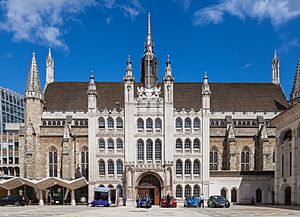
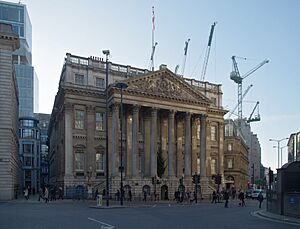
The City of London has a very special way of being governed. It's called the City of London Corporation. This is because the City has kept its unique status for a very long time, since Anglo-Saxon times.
The Corporation has two main groups: the Court of Aldermen and the Court of Common Council. The Lord Mayor of London leads the Corporation. This Lord Mayor is different from the Mayor of London, who governs the wider Greater London area. The Lord Mayor's job is much older!
The City is divided into 25 areas called wards. Each ward has an alderman, who is elected by the people and businesses in that ward. These wards have been around for a very long time and are a key part of the City's unique history.
Special Rules for Voting
The City of London has a unique voting system. Most voters are people who work for businesses in the City, not just residents. This is because the City is mainly a place for business, with over 500,000 people working there every day, compared to about 8,600 residents. This system allows businesses to have a say in how the City is run.
The Temple Area
Two special areas called Inner Temple and Middle Temple are within the City's boundaries. They are like independent neighborhoods. These areas are home to important legal groups called the Inns of Court, where lawyers are trained.
Other Important Roles
The City of London Corporation does many things. It owns and runs historic markets like Smithfield Market (for meat) and Leadenhall Market (for food). It also owns many parks and open spaces around London, like most of Epping Forest and Hampstead Heath.
The City has its own police force, the City of London Police, which is separate from the main London police force. It also helps fund the Old Bailey, a famous criminal court. The Corporation is also in charge of five bridges over the Thames, including London Bridge and Tower Bridge.
Geography of the City
The City of London is the smallest ceremonial county in England. It's also the smallest city in the UK by area. The land in the City goes from sea level near the Thames up to about 21 meters (70 feet) high. There are two small hills: Ludgate Hill in the west and Cornhill in the east.
City Boundaries
The City's boundaries were originally set by the old Roman London Wall. While most of the wall is gone, you can still see parts of it today. The City's borders have changed slightly over time, especially in 1994, to make sense with modern buildings.
You can spot the City's boundaries by looking for black posts with the City's emblem or special dragon statues at major entrances, like at Temple Bar on Fleet Street.
Gardens and Open Spaces
Even though the City is small and busy, it has many small gardens and open spaces. These range from formal gardens like Finsbury Circus to quiet churchyards. The River Thames also offers pleasant riverside walks.
Public Services
Police and Safety
The City of London has its own police force, the City of London Police. It's the smallest police force in England and Wales. Their police badges are black and gold, and their uniform has unique red and white checkered bands.
Because the City is such an important financial center, it has strong security measures. After some past incidents, a system of road barriers and cameras, sometimes called the "ring of steel," was put in place to help keep the City safe.
Fire Service
The City has one fire station, but it also gets help from fire stations in nearby areas. Firefighters respond very quickly to incidents in the City.
People of the City
| Historical population | ||
|---|---|---|
| Year | Pop. | ±% |
| 1801 | 130,117 | — |
| 1811 | 122,924 | −5.5% |
| 1821 | 127,040 | +3.3% |
| 1831 | 125,353 | −1.3% |
| 1841 | 127,514 | +1.7% |
| 1851 | 132,734 | +4.1% |
| 1861 | 108,078 | −18.6% |
| 1871 | 83,421 | −22.8% |
| 1881 | 58,764 | −29.6% |
| 1891 | 43,882 | −25.3% |
| 1901 | 32,649 | −25.6% |
| 1911 | 24,292 | −25.6% |
| 1921 | 19,564 | −19.5% |
| 1931 | 15,758 | −19.5% |
| 1941 | 10,920 | −30.7% |
| 1951 | 7,568 | −30.7% |
| 1961 | 5,718 | −24.4% |
| 1971 | 4,325 | −24.4% |
| 1981 | 4,603 | +6.4% |
| 1991 | 3,861 | −16.1% |
| 2001 | 7,186 | +86.1% |
| 2011 | 7,375 | +2.6% |
| 2021 | 8,600 | +16.6% |
| Sources: Office for National Statistics | ||
In 2021, about 8,600 people lived in the City of London. This number has grown a bit recently, especially with new homes being built in places like the Barbican Estate. However, the City is mostly a place for work, with over 500,000 people coming in to work each day.
The people who live in the City often earn more money than people in other parts of London or the UK. They also tend to have higher education levels. Most residents walk to work or use public transport like the Tube, as very few commute by car.
Economy of the City
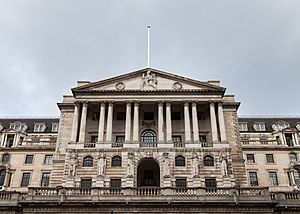
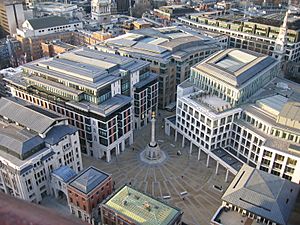
The City of London is one of the world's top financial centers, competing with places like New York City. It's home to the London Stock Exchange (where company shares are traded), Lloyd's of London (a famous insurance market), and the Bank of England (the UK's central bank). More than 500 banks have offices here.
London's foreign exchange market, where different currencies are traded, is huge. It handles almost half of all global currency trading every day!
While the City is mainly known for finance, it also has a strong legal profession, especially in the western parts. There are also shops, restaurants, and pubs, especially in areas like Bishopsgate. The historic Smithfield Market is still a major meat market, and Leadenhall Market sells fresh food and is a popular spot for visitors.
Many big global companies have their main offices in the City, including major banks and law firms.
Famous Landmarks
Historic Buildings
Even though the City has faced fires and bombings, it still has many beautiful old buildings. These include:
- The Monument to the Great Fire of London (a tall column).
- St Paul's Cathedral, a masterpiece by Sir Christopher Wren.
- The Guildhall, the City's historic government building.
- The Royal Exchange.
- Mansion House, the Lord Mayor's official home.
- Many historic churches, often designed by Christopher Wren.
You can also find small parts of the original Roman London Wall. The Tower of London, while not technically in the City, is very close and a popular place to visit. Other important historical buildings include the Bank of England, the Old Bailey (a famous court), and Leadenhall Market.
Skyscrapers and Tall Buildings
The City of London's skyline has changed a lot with many new, tall buildings. Most of these skyscrapers are used for offices by financial companies. They are mainly found in the eastern part of the City.
Here are some of the tallest buildings in the City:
| Rank | Name | Completed | Image | Architect | Use | Height to roof | Floors | Location | |
|---|---|---|---|---|---|---|---|---|---|
| metres | feet | ||||||||
| 1 | Twentytwo | 2020 |  |
PLP Architects | Office | 278 | 912 | 62 | 22 Bishopsgate |
| 2 | Heron Tower | 2010 |  |
Kohn Pedersen Fox | Office | 230 | 754 | 46 | 110 Bishopsgate |
| 3 | Leadenhall Building | 2014 |  |
Rogers Stirk Harbour + Partners | Office | 225 | 737 | 48 | 122 Leadenhall Street |
| 4 | 8 Bishopsgate | 2022 |  |
WilkinsonEyre | Office | 204 | 669 | 51 | 8 Bishopsgate |
| 5 | The Scalpel | 2018 |  |
Kohn Pedersen Fox | Office | 190 | 630 | 39 | 52 Lime Street |
| 6 | Tower 42 | 1980 |  |
R Siefert & Partners | Office | 183 | 600 | 47 | 25 Old Broad Street |
| 7 | 30 St Mary Axe | 2003 |  |
Foster and Partners | Office | 180 | 590 | 40 | 30 St Mary Axe |
| 8 | 100 Bishopsgate | 2019 |  |
Allies and Morrison | Office | 172 | 563 | 40 | 100 Bishopsgate |
| 9 | Broadgate Tower | 2008 |  |
SOM | Office | 164 | 538 | 35 | 201 Bishopsgate |
| 10 | 20 Fenchurch Street | 2014 |  |
Rafael Viñoly | Office | 160 | 525 | 37 | 20 Fenchurch Street |
| 11 | 40 Leadenhall Street | 2022 |  |
Make Architects | Office | 154 | 505 | 34 | 40 Leadenhall Street |
| 12 | One Bishopsgate Plaza | 2020 |  |
MSMR | Hotel | 135 | 443 | 44 | 150 Bishopsgate |
| 13 | CityPoint | 1967 |  |
F. Milton Cashmore and H. N. W. Grosvenor | Office | 127 | 417 | 36 | 1 Ropemaker Street |
| 14 | Willis Building | 2007 |  |
Foster and Partners | Office | 125 | 410 | 26 | 51 Lime Street |
| =15 | Cromwell Tower | 1973 | 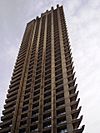 |
Chamberlin, Powell and Bon | Residential | 123 | 404 | 42 | Barbican Estate |
| =15 | Lauderdale Tower | 1974 |  |
Chamberlin, Powell and Bon | Residential | 123 | 404 | 42 | Barbican Estate |
| =15 | Shakespeare Tower | 1976 |  |
Chamberlin, Powell and Bon | Residential | 123 | 404 | 42 | Barbican Estate |
| 18 | St. Helen's | 1969 |  |
GMW Architects | Office | 118 | 387 | 28 | 1 Undershaft |
| 19 | The Heron | 2013 |  |
David Walker Architects | Residential | 112 | 367 | 35 | Milton Court |
| 20 | St Paul's Cathedral | 1710 |  |
Sir Christopher Wren | Cathedral | 111 | 365 | n/a | Ludgate Hill |
| 21 | 99 Bishopsgate | 1976 |  |
GMW Architects | Office | 104 | 340 | 26 | 99 Bishopsgate |
| 22 | One Angel Court | 2017 |  |
Fletcher Priest | Office | 101 | 331 | 24 | 1 Angel Court |
| 23 | Stock Exchange Tower | 1970 |  |
Richard Llewelyn-Davies, Baron Llewelyn-Davies, Weeks, Forestier-Walker and Bar | Office | 100 | 328 | 27 | 125 Old Broad Street |
Getting Around the City
The City of London is very well connected by public transport.
Trains and the Tube
Seven London Underground (or "Tube") lines serve the City. Some of the main Tube stations include:
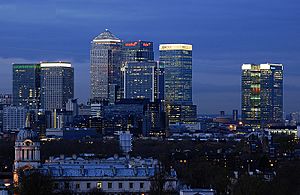
The Docklands Light Railway (DLR) also has two stations in the City: Bank and Tower Gateway. The DLR connects the City to places like Canary Wharf and London City Airport.
The Elizabeth line runs under the City, with stations at Farringdon and Liverpool Street. This line connects the City to Heathrow Airport and other areas.
The Thameslink train service runs through the City, stopping at Farringdon, City Thameslink, and London Blackfriars. This connects the City to places like Brighton and Gatwick Airport.
Several major train stations are in the City, offering services to different parts of England:
- London Blackfriars
- London Cannon Street
- London Fenchurch Street
- London Liverpool Street (including the Stansted Express to Stansted Airport)
- Moorgate
Roads and Buses
Major roads like the A1 and A10 start in the City. The City is part of the London congestion charge zone, which means drivers usually pay a fee to enter. The City is also well served by buses, including night buses.
Cycling
The City has many special routes for cyclists, called Cycle Superhighways and Cycleways. These routes help people cycle safely through the busy streets. There are also bike-sharing systems available.
River Transport
You can also travel by boat on the River Thames. The Blackfriars Millennium Pier is in the City, and the Tower Millennium Pier is very close by. There's also a public path along the river, called the Thames Path, which is great for walking.
Education in the City
The City of London has several higher education places, like the Guildhall School of Music and Drama and the Cass Business School. Parts of other universities, like King's College London, are also located here.
There is one primary school in the City, The Aldgate School, for children aged 4 to 11. For older children, the City Corporation supports three independent schools: City of London School (for boys), City of London School for Girls, and City of London Freemen's School. It also helps run several academies in other parts of London.
Libraries
The City has several public libraries. The Barbican Library, Shoe Lane Library, and Artizan Street Library are lending libraries. The Guildhall Library and City Business Library are special reference libraries, focusing on London's history and business information.
Images for kids
-
St Paul's Cathedral in 1896.
-
A plaque near Southwark Bridge about Alfred the Great.
-
A dragon statue at the Temple Bar monument, marking the City's boundary.
-
The Barbican Centre, a major arts venue in the City.
-
The Maughan Library of King's College London.
See also
 In Spanish: City de Londres para niños
In Spanish: City de Londres para niños










